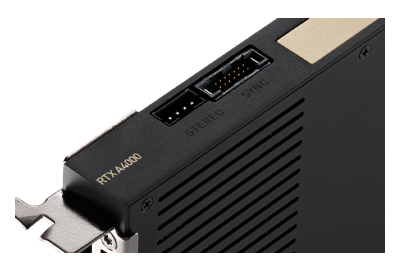NVIDIA RTX A4000 GPU - System Overview
Performance

The RTX A4000 uses the same 8nm GA104 graphics processor as the RTX 3070 Ti and both are based on the Ampere architecture. With 17,400 million transistors, the card features 48 second generation RT cores, which improve ray tracing hardware acceleration. The GPU also has 192 third-generation Tensor cores for enhanced AI inference and Deep Learning Super Sampling (DLSS) performance at higher resolutions, plus 6,144 Ampere CUDA cores for substantial performance gains in areas like 3D model building. For those with a smaller budget but big projects, this GPU can connect to a maximum of four 4096 x 2160 displays at 120Hz allowing users to create with uncompromised compute precision and dependability.
Memory
With up to 16GB of GDDR6 RAM gives this GPU a significant boost in performance with error-correction code (ECC), connected using a 256-bit memory interface. The GPU operates at 735 MHz, which can be boosted up to 1560 MHz under load.

Cooling and Power
The RTX A4000 offers a power-efficient, single-slot PCIe form factor that fits into a variety of workstation and server chassis. The max power consumption of 140W is delivered through a single 6-pin PCIe connector and is cooled by a single blower fan. This fan draws in cool air from the top and bottom of the card, pushes it through a radiator and then directly out of the rear of the machine, unlike consumer GeForce GPUs which use axial fans that recirculate air inside the system. Because of this, users can stack cards within the chassis. In addition, the display outputs include four DisplayPort 1.4a ports and can power up to four displays at 5K resolution and 60Hz.
Summary
The transition from 'Turing' to 'Ampere' is nothing short of remarkable. Although the NVIDIA RTX A4000 GPU is not recommended for gamers as it features error correcting code (ECC) and offers more reliable performance for enterprise applications. Professionals are able to take advantage of maximum power, at a fraction of the cost of a higher-end GPU. The single-slot card leverages the second-generation RTX Ampere architecture featuring 16GB of GDDR6 ECC memory, 48 RT cores, 192 Tensor cores, and 6,144 Ampere CUDA cores to take on any type of workflow in a growing business.
Check Availability



